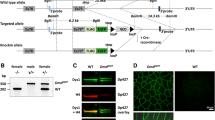Abstract
It has been shown previously that when utrophin is highly expressed in mice which lack dystrophin, the muscle pathology is prevented. Immunohistochemical evidence strongly suggests that utrophin in these transgenic mice occupies the position normally filled by dystrophin, although it is not possible to establish this firmly at the level of the light microscope. Using the higher resolution provided by the electron microscope, we demonstrate here by immunogold labelling with both monoclonal and polyclonal antibodies that utrophin, in both its truncated and full-length forms, is indeed specifically located in the subcellular position usually occupied by dystrophin in normal muscle. Moreover, when double-labelling of utrophin and β-dystroglycan was carried out, colocalisation of the two labels was often seen, indicating an association of the two proteins. Furthermore, when both utrophin and dystrophin were labelled in a transgenic line in which both were simultaneously expressed, the sites of both proteins were in the same zone in relation to the plasma membrane. When both proteins were present, the density of labelling of each was reduced compared with when they are expressed individually, suggesting that there is a finite number of binding sites. These results constitute further support for the view that utrophin might be therapeutically substituted for dystrophin in dystrophic muscle.
Similar content being viewed by others
References
Cullen MJ, Walsh M, Nicholson LVB, Harris JB (1990) Ultrastructural localization of dystrophin in human muscle using gold immunolabelling. Proc R Soc Lond B 240: 197–210.
Cullen MJ, Walsh J, Nicholson LVB, Harris JB, Zubrzycka-Gaarn, Ray PN, Worton RG (1991) Immunogold labelling of dystrophin in human muscle, using an antibody to the last 17 amino acids of the C-terminus. Neuromuscul Disord 1: 113–119.
Cullen MJ, Walsh J, Roberds S, Campbell KP (1996) Immunogold labelling of adhalin, alpha-dystroglycan and merosin in normal and dystrophic muscle. Neuropath Appl Neurobiol 22: 30–37.
Cullen MJ, Watkins SC (1993) Ultrastructure of muscular dystrophy: new aspects. Micron 24: 287–307.
Culligan K, Glover L, Dowling P, Ohlendieck K(2001) Brain dystrophin– glycoprotein complex: persistent expression of β-dystroglycan, impaired olgomerisation of Dp71 and up-regulation of utrophins in animal models of muscular dystrophy. BMC Cell Biol 2: 2–21.
Deconinck N, Tinsley J, De Backer F, Fisher R, Kahn D, Phelps S, Davies K, Gillis J-M (1997) Expression of truncated utrophin leads to major functional improvements in dystrophin-deficient muscles of mice. Nature Med 3: 1216–1221.
Emery AEH (1993) Duchenne Muscular Dystrophy. Oxford: Oxford Medical Publications.
Ervasti JM, Campbell KP (1991) Membrane organization of the dystrophin–glycoprotein complex. Cell 66: 1121–1131.
Henry MD, Campbell KP (1999) Dystroglycan inside and out. Curr Opin Cell Biol 11: 602–607.
Inoue M, Wakayama Y, Murahashi M, Shibuya S, Jimi T, Kojima H, Oniki H (1996) Electron microscopic observations of triple immunogold labelling for dystrophin, β-dystroglycan and adhalin in human skeletal myofibers. Acta Neuropathol 92: 569–575.
Koenig M, Kunkel LM (1990) Detailed analysis of the repeat domain of dystrophin reveals four potential hinge segments that may confer flexibility. J Biol Chem 265: 4560–4566.
Lin S, Burgunder J-M (2000) Utrophin may be a precursor of dystrophin during skeletal muscle development. Dev Brain Res 119: 289–295.
Morris GE (1997) Dystrophin is replaced by utrophin in frog heart; implications for muscular dystrophy. Neuromuscul Disord 7: 493–498.
Partridge TA (1997) Models of dystrophinopathy, pathological mechanisms and assessment of therapies. In: Brown SC, Lucy JA, eds. Dystrophin, Gene, Protein and Cell Biology. Cambridge: Cambridge University Press, pp. 310–331.
Tinsley J, Deconinck N, Fisher R, Kahn D, Phelps S, Gillis J-M, Davies K (1998) Expression of full-length utrophin prevents muscular dystrophy in mdx mice. Nature Med 4: 1441–1444.
Tinsley JM, Potter AC, Phelps SR, Fisher R, Trickett JI, Davies KE (1996) Amelioration of the dystrophic phenotype of mdx mice using a truncated dystrophin transgene. Nature 384: 349–353.
Wakefield PM, Tinsley JM, Wood MJ, Gilbert R, Karpati G, Davies KE (2000) Prevention of the dystrophic phenotype in dystrophin/utrophindeficient muscle following adenovirus-mediated transfer of a utrophin minigene. Gene Ther 7: 201–204.
Watkins SC, Cullen MJ, Hoffman EP, Billington L (2000) Plasma membrane cytoskeleton: a fine structural analysis. Microsc Res Tech 48: 131–141.
Zubrzycka-Gaarn EE, Bulman DE, Karpati G, Burghes AHM, Belfall B, Klamut HJ, Talbot J, Hodges RS, Ray PN, Worton RG (1988) The Duchenne muscular dystrophy gene product is located in sarcolemma of human skeletal muscle. Nature 333: 466–469.
Author information
Authors and Affiliations
Rights and permissions
About this article
Cite this article
Cullen, M.J., Walsh, J.M., Tinsley, J.M. et al. Immunogold Confirmation that Utrophin is Localized to the Normal Position of Dystrophin in Dystrophin-negative Transgenic Mouse Muscle. Histochem J 33, 579–583 (2001). https://doi.org/10.1023/A:1014964127156
Issue Date:
DOI: https://doi.org/10.1023/A:1014964127156




